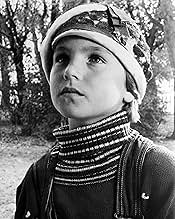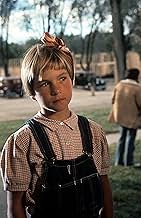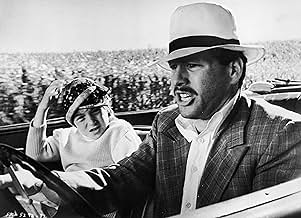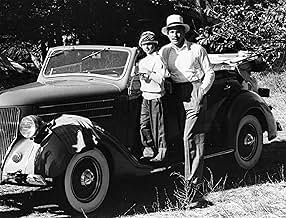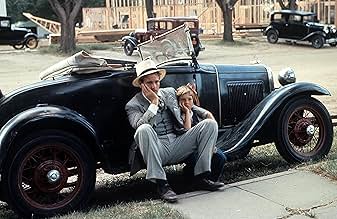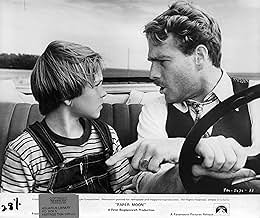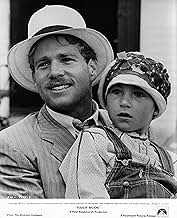Durante a Grande Depressão, um golpista cuida de uma jovem que pode ou não ser sua filha, mas os dois criam um relacionamento improvável.Durante a Grande Depressão, um golpista cuida de uma jovem que pode ou não ser sua filha, mas os dois criam um relacionamento improvável.Durante a Grande Depressão, um golpista cuida de uma jovem que pode ou não ser sua filha, mas os dois criam um relacionamento improvável.
- Direção
- Roteiristas
- Artistas
- Ganhou 1 Oscar
- 9 vitórias e 10 indicações no total
James N. Harrell
- The Minister
- (as Jim Harrell)
- Direção
- Roteiristas
- Elenco e equipe completos
- Produção, bilheteria e muito mais no IMDbPro
Avaliações em destaque
As cute and sharp as it's 9-year-old star Tatum O'Neal, Paper Moon is a bona-fide gem that says that, one way or another, we're all con artists. The acting is wonderful (Ryan O'Neal was never better), the cinematography is exceptional and it's to the eternal credit of director Bogdanovich and his writer Alvin Sargeant that the caper never sinks into mushiness. By avoiding the earnestness that pervades so many Depression Era tales and perfectly balancing character with situation, it rolls along so merrily that you don't realise how touching it is until the very end.
Having (criminally) never seen Paper Moon before, I suspect that it must have had more than a passing influence on a great many other movies, including my all-time favourite Midnight Run. Watching it is an experience to be savoured and treasured, and one that I'm looking forward to repeating time and again.
Having (criminally) never seen Paper Moon before, I suspect that it must have had more than a passing influence on a great many other movies, including my all-time favourite Midnight Run. Watching it is an experience to be savoured and treasured, and one that I'm looking forward to repeating time and again.
A sunny charmer with clouds enough to darken the edges of the screen, "Paper Moon" presents us with an entertainment of equal parts wit and sentiment, an underdog story that delivered a real underdog outcome in the form of a historic Oscar win for nine-year- old Tatum O'Neal.
In the time of the Great Depression, a little girl named Addie (Tatum) is left abandoned by the death of her mother, a woman who hung around in bars and left Addie with a big mystery as far as the identity of her father is concerned. At her gravesite, a dodgy stranger named Moses (Ryan O'Neal) happens by to pay his respects, and is immediately recruited by the other mourners, who don't want to be burdened with the girl, with the assignment of delivering Addie to her next-of-kin.
"God works in mysterious ways," one of the mourners says, after Moses reluctantly accepts.
"Don't He now?" Moses replies.
God indeed may have some unfinished business with Moses Pray, a conman who uses the Good Book as his device for fleecing newly-made widows of a few bucks. Watching the O'Neals work their family chemistry for sparks and laughs while Moses, with unexpected help from Addie, works his scams, is great fun. A lingering question is whether Moses and Addie are in fact related; many in the movie point out their similar jawlines, but Moses refuses to accept the idea. Addie is more open to it. Clearly Moses for all his faults fills a hole in her life.
There was a time when Peter Bogdanovich could do no wrong as a director; here he presents us with an assured callback to 1930s- period sensibilities by employing a flat Kansas landscape and scenic design that suggests a combination of Norman Rockwell and Grant Wood, at once homey and vaguely grotesque. The story moves fast, the dialogue is crisp and believable, and the O'Neals' performances of such strong quality as to make you wonder why they so seldom impressed in other roles. The talent is there on the screen.
Tatum was the real surprise here; decades later, long after the flash of her career faded, it's hard not to be as bowled over by what she gives you as all those critics and movie-goers were so long ago. Avoiding the cutesiness of child actors, she plays her character as sharp-tongued and vinegary, with a hint of real beauty beneath the smudges. "Ain't she got a sweet little face, somehow," is the best anyone can manage in the way of compliments, but Addie don't need them. She just wants her 200 dollars, or "two hundra DOLLA" as she keeps putting it to Moses.
The two of them make such a pair I get annoyed when Madeline Kahn joins them for a time as a conniving, cheapjack vixen named Trixie. Unlike the O'Neals, Kahn is an actress I usually enjoy in anything, so why is she so duff to me here? Trixie is a one-note performance that grates on me; I can't wait for the Prays to leave her in their dust.
I did enjoy P. J. Johnson as Trixie's put-upon maid, Imogene. She adds some heart and gives Addie some company for some of the movie's best scenes. So too does a raft of supporting players, most of whom like Kahn must have been waiting for Mel Brooks' call-backs for "Blazing Saddles" at the time of this production.
Mostly, though, this is Tatum's film; it rises or falls with her and, as a result of her spry performance, rises quite impressively. Bogdanovich clearly gambled putting his promising career on her little shoulders; unlike later gambles of his this paid off spectacularly and yields dividends to this day.
In the time of the Great Depression, a little girl named Addie (Tatum) is left abandoned by the death of her mother, a woman who hung around in bars and left Addie with a big mystery as far as the identity of her father is concerned. At her gravesite, a dodgy stranger named Moses (Ryan O'Neal) happens by to pay his respects, and is immediately recruited by the other mourners, who don't want to be burdened with the girl, with the assignment of delivering Addie to her next-of-kin.
"God works in mysterious ways," one of the mourners says, after Moses reluctantly accepts.
"Don't He now?" Moses replies.
God indeed may have some unfinished business with Moses Pray, a conman who uses the Good Book as his device for fleecing newly-made widows of a few bucks. Watching the O'Neals work their family chemistry for sparks and laughs while Moses, with unexpected help from Addie, works his scams, is great fun. A lingering question is whether Moses and Addie are in fact related; many in the movie point out their similar jawlines, but Moses refuses to accept the idea. Addie is more open to it. Clearly Moses for all his faults fills a hole in her life.
There was a time when Peter Bogdanovich could do no wrong as a director; here he presents us with an assured callback to 1930s- period sensibilities by employing a flat Kansas landscape and scenic design that suggests a combination of Norman Rockwell and Grant Wood, at once homey and vaguely grotesque. The story moves fast, the dialogue is crisp and believable, and the O'Neals' performances of such strong quality as to make you wonder why they so seldom impressed in other roles. The talent is there on the screen.
Tatum was the real surprise here; decades later, long after the flash of her career faded, it's hard not to be as bowled over by what she gives you as all those critics and movie-goers were so long ago. Avoiding the cutesiness of child actors, she plays her character as sharp-tongued and vinegary, with a hint of real beauty beneath the smudges. "Ain't she got a sweet little face, somehow," is the best anyone can manage in the way of compliments, but Addie don't need them. She just wants her 200 dollars, or "two hundra DOLLA" as she keeps putting it to Moses.
The two of them make such a pair I get annoyed when Madeline Kahn joins them for a time as a conniving, cheapjack vixen named Trixie. Unlike the O'Neals, Kahn is an actress I usually enjoy in anything, so why is she so duff to me here? Trixie is a one-note performance that grates on me; I can't wait for the Prays to leave her in their dust.
I did enjoy P. J. Johnson as Trixie's put-upon maid, Imogene. She adds some heart and gives Addie some company for some of the movie's best scenes. So too does a raft of supporting players, most of whom like Kahn must have been waiting for Mel Brooks' call-backs for "Blazing Saddles" at the time of this production.
Mostly, though, this is Tatum's film; it rises or falls with her and, as a result of her spry performance, rises quite impressively. Bogdanovich clearly gambled putting his promising career on her little shoulders; unlike later gambles of his this paid off spectacularly and yields dividends to this day.
PAPER MOON is one of those films which refuses to age or become dated, because, as director Peter Bogdanovich claims, it was dated when it was released. It has the look and presence of a film from the Golden Thirties with the panache and style that could only come from the Golden Seventies. That extraordinary decade when the Old Hollywood Studio Machine was being rapidly replaced by the rise of the Artist Filmmaker, who were young, eager and just out of film school. A wonderful period of flux when anything could and did happen. A seminal period in filmmaking where new artists were making important new films, which would change Hollywood forever. PAPER MOON is outwardly a period road picture set in the mid 30s, about a traveling man named Moze Pray (Ryan O'Neil) who will play any angle if it means a couple of extra dollars in his pocket. As the story opens he agrees to escort the daughter of a now deceased lover to her Aunt in Missouri. Slick Moze quickly meets his match in the half pint tough little Addie Loggins (Ryan's real life daughter Tatum in her first role). No sentimental tear jerker here, this is a great story which refuses to go down the obvious road of a father reunited with his lost little girl; we aren't even sure it's really his daughter. Little Addie is tough as nails at every turn and a whole lot more savvy than Moze could ever be. At turn after turn she will outsmart and outmaneuver Moze in a way which is a sheer delight to watch. Tatum O'Neil gives an Oscar caliber performance as little Addie, but why she was given a Best Supporting Actress award and not nominated for the Best Actress category, one can only wonder. Madeline Kahn (What's Up Doc, Blazing Saddles), in her second film ever also delivers the goods as Miss Trixie Delight who meets up with the pair and sees her own angle. Everyone is playing some angle in this film and we get to enjoy every minute of it.
Shot completely on locations in Kansas and Missouri PAPER MOON sparkles with a richness only capable in black and white. Cinematographer Lazlo Kovacs is a great camera artist and never better than PAPER MOON where he uses black and white, deep focus and those great long takes to its best advantage. To the untrained eye it will just appear very sharp, but look closely at each frame and notice that everything is in tack sharp focus from the closest object to far in the distance. This deep focus is very difficult to achieve correctly, especially in the night shots, but Kovacs does it so well it is seamless. Watch for the train station sequence where even the children playing in the background are razor sharp. This is a look that can only be achieved using black and white to its fullest potential. New filmmakers take notice. This is how it's supposed to be done. All this cinematic brilliance would be wasted were it not for the wonderful direction of Bogdanovich. In this his third film, he proves that he is a consummate filmmaker who knows how to move the actors and camera in perfect concert. His craftsmanship of each scene is unmistakable as he brings a fresh and very new approach using Hollywood tricks which are decades old. A lesser director might have used process shots and sets to tell the story, but not Bogdanovich. He shot the entire film in real locations to give it the look and feel of a real thirties road picture. You can almost smell the wide plains and feel the dust as it comes up to slap you in the face. Notice too how he never resorts to sentimentality to move the story along, it is told razor sharp and without tears. This, never more apparent than the final sequence where he pays off the film in grand style.
There is only one thing about this film which still baffles me. Why in the night time hotel sequence toward the end of the film were electric lights everywhere but inside the hotel lobby, which was lit entirely with kerosine lamps? Was it to give the look and feel of the period, or did the real location use them? Small point, but interesting. If, like myself, the last time you saw PAPER MOON was when it was released in 1973, see it again on DVD and be delighted all over again. The DVD transfer is marvelous and only serves to heighten its visual appeal. If you have only seen PAPER MOON on broadcast TV, do yourself a favor and see the new DVD for a pleasant surprise. Without the obligatory broadcast TV commercials, pan and scan and dialogue cuts this will appear like a new film seen the way it was supposed to be seen. And if you have NEVER seen PAPER MOON and harbor some prejudice against black and white films, please see this film. Any preconceived notions against this format will quickly dissolve as it takes you along for a rich ride with Addie and Moze in the only format it could - glorious black and white.
Shot completely on locations in Kansas and Missouri PAPER MOON sparkles with a richness only capable in black and white. Cinematographer Lazlo Kovacs is a great camera artist and never better than PAPER MOON where he uses black and white, deep focus and those great long takes to its best advantage. To the untrained eye it will just appear very sharp, but look closely at each frame and notice that everything is in tack sharp focus from the closest object to far in the distance. This deep focus is very difficult to achieve correctly, especially in the night shots, but Kovacs does it so well it is seamless. Watch for the train station sequence where even the children playing in the background are razor sharp. This is a look that can only be achieved using black and white to its fullest potential. New filmmakers take notice. This is how it's supposed to be done. All this cinematic brilliance would be wasted were it not for the wonderful direction of Bogdanovich. In this his third film, he proves that he is a consummate filmmaker who knows how to move the actors and camera in perfect concert. His craftsmanship of each scene is unmistakable as he brings a fresh and very new approach using Hollywood tricks which are decades old. A lesser director might have used process shots and sets to tell the story, but not Bogdanovich. He shot the entire film in real locations to give it the look and feel of a real thirties road picture. You can almost smell the wide plains and feel the dust as it comes up to slap you in the face. Notice too how he never resorts to sentimentality to move the story along, it is told razor sharp and without tears. This, never more apparent than the final sequence where he pays off the film in grand style.
There is only one thing about this film which still baffles me. Why in the night time hotel sequence toward the end of the film were electric lights everywhere but inside the hotel lobby, which was lit entirely with kerosine lamps? Was it to give the look and feel of the period, or did the real location use them? Small point, but interesting. If, like myself, the last time you saw PAPER MOON was when it was released in 1973, see it again on DVD and be delighted all over again. The DVD transfer is marvelous and only serves to heighten its visual appeal. If you have only seen PAPER MOON on broadcast TV, do yourself a favor and see the new DVD for a pleasant surprise. Without the obligatory broadcast TV commercials, pan and scan and dialogue cuts this will appear like a new film seen the way it was supposed to be seen. And if you have NEVER seen PAPER MOON and harbor some prejudice against black and white films, please see this film. Any preconceived notions against this format will quickly dissolve as it takes you along for a rich ride with Addie and Moze in the only format it could - glorious black and white.
If Hayes, Kansas, and thereabouts...were the perfect locations for Peter Bogdonavich's classic "Paper Moon," then the film itself is the perfect realization of those real places forever etched in celluloid.
Few times will you ever see a film so visually wedded to its locale and cinematic style. In a typical film, you might picture the presentation of the movie working in a number of ways, but in "Paper Moon," it will forever seem like it could only have been done this way...on location, in black and white, and photographed like moving Andrew Wyeth shots of Americana.
Tatum O' Neal is terrific and justifiably won an Oscar for her part, but Ryan is wonderful as well....funny in that exasperated manner that Bud Abbott is, and the quality goes right down to the smallest bit player in the cast.
A perfect film would have great acting, great visuals and utilization of music, a superb story and lines that have you repeating them for years. Welcome to "Paper Moon." I can't recommend this blend of comedy and drama enough. A modern classic.
Few times will you ever see a film so visually wedded to its locale and cinematic style. In a typical film, you might picture the presentation of the movie working in a number of ways, but in "Paper Moon," it will forever seem like it could only have been done this way...on location, in black and white, and photographed like moving Andrew Wyeth shots of Americana.
Tatum O' Neal is terrific and justifiably won an Oscar for her part, but Ryan is wonderful as well....funny in that exasperated manner that Bud Abbott is, and the quality goes right down to the smallest bit player in the cast.
A perfect film would have great acting, great visuals and utilization of music, a superb story and lines that have you repeating them for years. Welcome to "Paper Moon." I can't recommend this blend of comedy and drama enough. A modern classic.
10dtrobb
There are different reasons to watch different movies. Plot, scenery, acting, music score, special effects ...Let's make this as simple as possible.
The plot is OK. The setting/location/cinematography is OK. I liked Ryan O'Neal in Love Story and What's Up Doc. He's good enough here.
But, this movie is a 10 for one, and only one, reason. Ten year old Tatum O'Neal is impossible to take your eyes off of the entire movie. I challenge anyone to name a better performance by an actress/actor in a movie than this one by Ms. O'Neal.
What a joke she won the Oscar for Best Supporting Actress because the Academy didn't think a ten year old should win the Best Actress award.
She's on screen only about 95% of the time.
I love what Madeline Kahn says about that. MK says she - MK- should have won Best Supporting Actress. Tatum should have won Best Actress.
The plot is OK. The setting/location/cinematography is OK. I liked Ryan O'Neal in Love Story and What's Up Doc. He's good enough here.
But, this movie is a 10 for one, and only one, reason. Ten year old Tatum O'Neal is impossible to take your eyes off of the entire movie. I challenge anyone to name a better performance by an actress/actor in a movie than this one by Ms. O'Neal.
What a joke she won the Oscar for Best Supporting Actress because the Academy didn't think a ten year old should win the Best Actress award.
She's on screen only about 95% of the time.
I love what Madeline Kahn says about that. MK says she - MK- should have won Best Supporting Actress. Tatum should have won Best Actress.
Você sabia?
- CuriosidadesTatum O'Neal was ten years old when she won the Academy Award for Best Supporting Actress for her performance in this movie, making her the youngest person ever to win an Oscar in a competitive category. As of 2023, she still holds this record. She was four years younger than her rival nominee, Linda Blair, in O Exorcista (1973).
- Erros de gravaçãoWhen Addie is reading the obituary of Mr. Morgan, just above and below Mr. Morgan's are two obituaries - one Bessie Lees and one Oscar G. Olsen, both entering rest on April 28th, 1971. This film takes place in the mid-30s. Also worth noting is some of the obituaries state San Francisco as the home of a few of the deceased. This film takes place throughout Kansas and Western Missouri.
- Citações
[repeated line]
Addie Loggins: I want my two hundred dollars!
- Cenas durante ou pós-créditosSpecial thanks to the people in and around Hays, Kansas and St. Joseph, Missouri
- Trilhas sonorasIt's Only a Paper Moon
(1933) (uncredited)
Music by Harold Arlen
Lyrics by E.Y. Harburg and Billy Rose
Performed by Paul Whiteman and Orchestra
Vocal by Peggy Healy
Principais escolhas
Faça login para avaliar e ver a lista de recomendações personalizadas
Detalhes
- Data de lançamento
- País de origem
- Idioma
- Também conhecido como
- Luna de papel
- Locações de filme
- Wilson, Kansas, EUA(Pray getting Addie's money at Robertson's mill, Hairdresser and General store on Avenue E)
- Empresas de produção
- Consulte mais créditos da empresa na IMDbPro
Bilheteria
- Orçamento
- US$ 2.500.000 (estimativa)
- Faturamento bruto mundial
- US$ 591
- Tempo de duração1 hora 42 minutos
- Cor
- Mixagem de som
- Proporção
- 1.85 : 1
Contribua para esta página
Sugerir uma alteração ou adicionar conteúdo ausente




